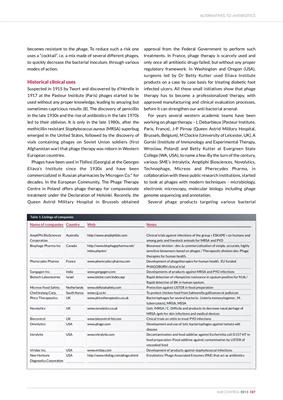
becomes resistant to the phage. To reduce such a risk one
uses a "cocktail", i.e. a mix made of several different phages,
to quickly decrease the bacterial inoculum, through various
modes of action.
Historical clinical uses
Suspected in 1915 by Twort and discovered by d'Hérelle in
1917 at the Pasteur Institute (Paris) phages started to be
used without any proper knowledge, leading to amazing but
sometimes capricious results (8). The discovery of penicillin
in the late 1930s and the rise of antibiotics in the late 1970s
led to their oblivion. It is only in the late 1980s, after the
methicillin resistant Staphylococcus aureus (MRSA) superbug
emerged in the United States, followed by the discovery of
vials containing phages on Soviet Union soldiers (first
Afghanistan war) that phage therapy was reborn in Western
European countries.
Phages have been used in Tbilissi (Georgia) at the Georges
Eliava's Institute since the 1930s and have been
commercialized in Russian pharmacies by Microgen Co.
® for
decades. In the European Community, The Phage Therapy
Centre in Poland offers phage therapy for compassionate
treatment under the Declaration of Helsinki. Recently, the
Queen Astrid Military Hospital in Brussels obtained
approval from the Federal Government to perform such
treatments. In France, phage therapy is scarcely used and
only once all antibiotic drugs failed, but without any proper
regulatory framework. In Washington and Oregon (USA),
surgeons led by Dr Betty Kutter used Eliava Institute
products on a case by case basis for treating diabetic foot
infected ulcers. All these small initiatives show that phage
therapy has to become a professionalized therapy, with
approved manufacturing and clinical evaluation processes,
before it can strengthen our anti-bacterial arsenal.
For years several western academic teams have been
working on phage therapy - L Debarbieux (Pasteur Institute,
Paris, France), J-P Pirnay (Queen Astrid Military Hospital,
Brussels, Belgium), M Clockie (University of Leicester, UK), A
Gorski (Institute of Immunology and Experimental Therapy,
Wroclaw, Poland) and Betty Kutter at Evergreen State
College (WA, USA), to name a few. By the turn of the century,
various SME's Intralytix, Ampliphi Biosciences, Novolytics,
Technophage, Micreos and Pherecydes Pharma, in
collaboration with these public research institutions, started
to look at phages with modern techniques - microbiology,
electronic microscopy, molecular biology including phage
genome sequencing and annotation.
Several phage products targeting various bacterial
ALTERNATIVES TO ANTIBIOTICS
AMR CONTROL 2015 107
Table 1: Listings of companies
Name of companies
AmpliPhi BioSciences
Corporation
Biophage Pharma Inc
Pherecydes Pharma
Gangagen Inc.
Biotech Laboratories
Micreos Food Safety
CheilJedang Corp.
Phico Therapeutics
Novolytics
Biocontrol
Omnilytics
Intralytix
Viridax Inc.
New Horizons
Diagnostics Corporation
Web
http://www.ampliphibio.com
http://www.biophagepharma.net/
index.php/en/
www.pherecydes-pharma.com
www.gangagen.com
www.biotec.com/index.asp
www.ebifoodsafety.com
www.cjj.co.kr
www.phicotherapeutics.co.uk
www.novolytics.co.uk
www.biocontrol-ltd.com
www.phage.com
www.intralytix.com
www.viridax.com
http://www.nhdiag.com/phage.shtml
Country
Australia
Canada
France
India
Israel
Netherlands
South Korea
UK
UK
UK
USA
USA
USA
USA
Notes
Clinical trials against infections of the group « ESKAPE » on humans and
among pets and livestock animals for MRSA and PYO
Biosensor division : dev. & commercialization of simple, accurate, highly
sensitive biosensors based on phages / Therapeutic division dev. Phage
therapies for human health.
Development of phagetherapies for human health. EU funded
PHAGOBURN clinical trial
Developments of products against MRSA and PYO infections
Rapid detection of rifampicine resistance in sputum positive for m.tb /
Rapid detection of BK in human sputum
Protection against LISTER in food preparation
To protect chicken feed from Salmonella gallinarum et pullorum
Bacteriophages for several bacteria : Listeria monocytogenes , M.
tuberculosis), MRSA, MSSA
Gels /MRSA / C. Difficile and products to decrease nasal portage of
MRSA /gels for skin infections and medical devices
Cinical trials on otitis to treat PYO infections
Development and use of lytic bacteriophages against tomato wilt
disease
Decontamination and food additive against Escherichia coli O157:H7 in
food preparation /Food additive against contamination by LISTER of
uncooked food
Development of products against staphylococcal infections.
Enzybiotics: Phage Associated Enzymes (PAE) that act as antibiotics